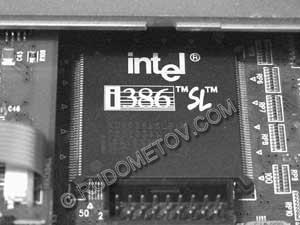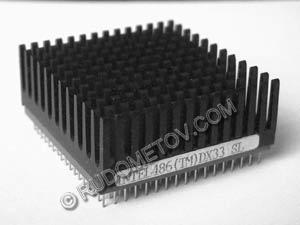Names and short parametres of processors. A part 1.
(Continuation)
Evgenie Rudometov, Victor Rudometov.
authors@rudometov.com
i80386SX (On June, 16th, 1988 ) — modification i80386, working clock rate of 16-33 MHz. The processor with clock rate of 20 MHz provided 2,5 million op/with, 25 MHz — 2,7 million op/with, 33 MHz — 2,9 million op/with. Incorporated 275 thousand transistors, processing technique 1,5 microns and 1 micron, internal digit capacity of 32 bits, the external data bus of 16 bits, the bus of 32 address of bats, address space of 4 Gbytes, the virtual storage of 64 Tbyte. The processor i80386 used in PC PC/AT-386 and PS/2.
i80386SL (On October, 15th, 1990 ) — modification i80386 with low energopotrebleniem, working clock rate of 20 and 25 MHz. The processor with clock rate of 20 MHz provided 4,21 million op/with, 25 MHz — 5,3 million op/with. 1 micron, internal digit capacity of 32 bits, the external data bus of 16 bits, address space of 4 Gbytes, the virtual storage of 64 Tbyte incorporated 855 thousand transistors, processing technique . Vysokointegrirovannaja the architecture includes the cache memory, the bus and controls for memory. The processor i80386SL was the first processor specially developed for computers of type Notebook.

Fig. 6. The processor i80386SL in computer Notebook
i80486DX (On April, 10th, 1989 ) — Working clock rate of 25-50 MHz, 20-40 million operations second, 1,2 million transistors, processing technique 1 microns (processors of 50 MHz — 0,8 microns), internal digit capacity of 32 bits, the bus of 32 address of bats, address space of 4 Gbytes, the virtual storage of 64 Tbyte. In comparison with the processor i8088, productivity has increased in 50 times. Used in the PC with the processor 486 and PS/2. The development purpose was the increase in productivity and the big complexity in comparison with existing i80386 architecture. 6 additional commands, the internal math coprocessor, an additional scratch-pad memory — a RAM cache for storage of often used information, a pipelining etc. are provided . Different modifications of the given processor are released: SX, SL, DX, SX2, DX2, DX4 and others, differing an inner pattern, productivity, a transfer rate, supply voltages, consumption currents, features of maintenance etc .

Fig. 7. A processor kernel i80486
i80486SX
(On April, 22nd, 1991 ) — modification i80486, working clock rate of 16-33 MHz. The processor with clock rate of 16 MHz provided 13 million op/with, 20 MHz — 16,5 million op/with, 25 MHz — 20 million op/with, 33 MHz — 27 million op/with. Incorporated 1 185 000 transistors (processing technique 1 micron) or 900 000 transistors (0,8 microns), internal digit capacity of 32 bits, the external data bus of 32 bits, the bus of 32 address of bats, address space of 4 Gbytes, the virtual storage of 64 Tbytes, the internal cache memory of 8 Kbytes, use in the PC with the processor 486 and PS/2. Is clone i486DX, but without the built in math coprocessor. There is a possibility of upgrade by installation of the processor of Intel OverDrive. This processor became standard by operation with the built in applications.
Fig. 8. The processor i80486SX
i80486DX2
(On March, 3rd, 1992 ) — modification i80486, doubling of external clock rate of 25-33 MHz, internal clock rate of 50-66 MHz. The processor with clock rate of 50 MHz provided 41 million op/with (29.9 SPECint92, 14.2 SPECfp92 on system Micronics M4P from 256 Kbytes of the cache memory of the second level), 66 MHz — 54 million op/with (39.6 SPECint92, 18.8 SPECfp92 on system Micronics M4P from 256 Kbytes of the cache memory of the second level). Of 64 Tbyte, the internal cache memory of 8 Kbytes incorporated 1,2 million transistors, 0,8 microns processing technique, internal digit capacity of 32 bits, the external data bus of 32 bits, the bus of 32 address of bats, address space of 4 Gbytes, the virtual storage . Thanks to processing technique application "the doubled frequency" the microprocessor kernel works twice faster buses. Used in PC PC/AT-486 and PS/2.i80486SL
(On November, 9th, 1992 ) — clock rate of 20-33 MHz, 1,4 million transistors, 0,8 microns processing technique, digit capacity of the bus of 32 bits. It is intended for computers Notebook
Fig. 9. The processor i80486SL
i80486DX4
(On March, 7th, 1994 ) — modification i80486, trebling of external clock rate of 25-33 MHz, internal clock rate of 75-100 MHz. The processor with clock rate of 75 MHz provided 53 million op/with (41.3 SPECint92, 20.1 SPECfp92 on system Micronics M4P from 256 Kbytes of the cache memory of the second level), 100 MHz — 70,7 million op/with (54.59 SPECint92, 26.91 SPECfp92 on system Micronics M4P from 256 Kbytes of the cache memory of the second level).Of 64 Tbyte, the internal cache memory of the increased size — 16 Kbytes, a supply voltage 3 In, a chip of 345 square mm, PGA 168, SQFP 208 incorporated 1,6 million transistors, 0,6 microns processing technique, internal digit capacity of 32 bits, the external bus of 32 bits, address space of 4 Gbytes, the virtual storage . Used in PC PC/AT-486 and cost-intensive computers Notebook.
This processor has been released already after issue of the first models of following generation. The new, more powerful processors of P5 architecture received the name of Pentium and possessing higher clock rates, have step-by-step superseded the predecessors. But about it in the following part.
To pass to razrelu Processors
 English
English Russian
Russian German
German